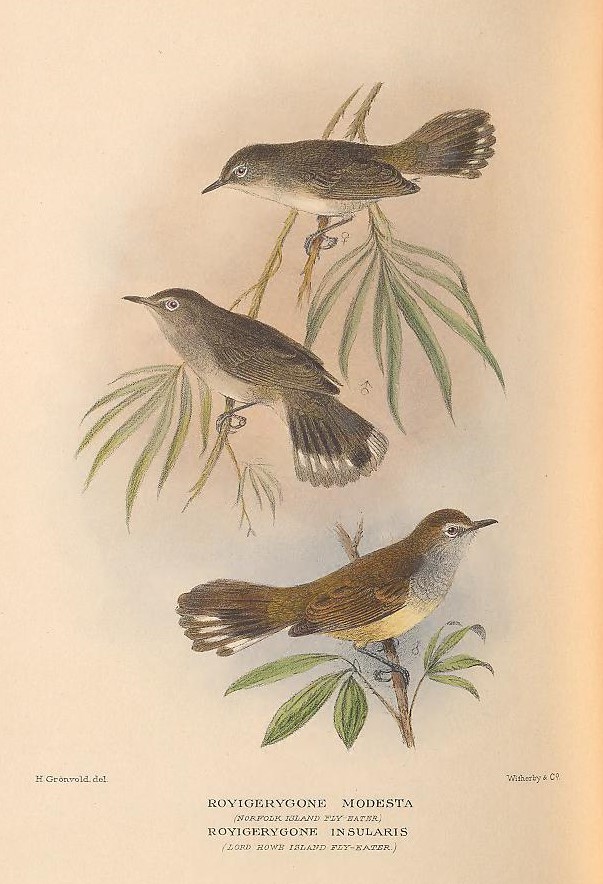Gerygone insularis Ramsay, 1878:117
Lord Howe (Island) gerygone, Lord Howe Island flycatcher, Rain-bird, Pop-goes-the-Weasel, Lord Howe Island fly-eater
Taxonomy & Nomenclature
Synonym/s: Royigerygone insularis Ramsay, 1879; Pseudogerygone insularis Ramsay, 1879; Gerygone igata insularis Ramsay, 1879; Gerygone Thorpei Ramsay, 1887:677
Conservation Status
Extinct
Last record: 1928 (Sharland, 1929; Kittelberger et al., 2024)
IUCN RedList status: Extinct
Distribution
Lord Howe Island, New South Wales, Australia
Biology & Ecology
Hypodigm
Media

Above: illustration (bottom bird) from Mathews (1928).
References
Original scientific description:
Ramsay, E. P. (1878). On two new species of Gerygone. Proceedings of the Linnean Society of New South Wales 3: 116-118.
Other references:
BirdLife International. (2012). Gerygone insularis. In: IUCN 2012. IUCN Red List of Threatened Species. Version 2012.2. (http://www.iucnredlist.org). Downloaded on 29 May 2013.
BirdLife International. 2016. Gerygone insularis. The IUCN Red List of Threatened Species 2016: e.T22704724A93982219. https://dx.doi.org/10.2305/IUCN.UK.2016-3.RLTS.T22704724A93982219.en. Downloaded on 27 June 2021.
Brooks, T. 2000. Extinct species. In: BirdLife International (ed.), Threatened Birds of the World, pp. 701-708. Lynx Edicions and BirdLife International, Barcelona and Cambridge, U.K.
Christidis, L. and Boles, Walter E. (2008). Systematics and Taxonomy of Australian Birds. CSIRO Publishing, Collingwood, Australia.
Day, David. (1981). The Doomsday Book of Animals: A Natural History of Vanished Species. New York, N.Y.: The Viking Press.
Department of Environment and Climate Change (NSW). (2007). Lord Howe Island Biodiversity Management Plan Appendices. Department of Environment and Climate Change (NSW), Sydney. vii + 267 pp.
del Hoyo, J., Collar, N.J., Christie, D.A., Elliott, A., Fishpool, L.D.C., Boesman, P. and Kirwan, G.M. 2016. HBW and BirdLife International Illustrated Checklist of the Birds of the World. Volume 2: Passerines. Lynx Edicions and BirdLife International, Barcelona, Spain and Cambridge, UK.
Etheridge, R. (1889). The general zoology of Lord Howe Island; containing also an account of the collections made by the Australian Museum Collecting Party, Aug.–Sept., 1887. Australian Museum Memoir 2(1): 1-42, plates iv-v.
Ford, J. (1986). Phylogeny of the acanthizid warbler genus Gerygone based on numerical analyses of morphological characters. Emu 86: 12-22.
Garnett, Stephen (ed.). (1992). Threatened and Extinct Birds of Australia. RAOU Report Number 82. 212 pp.
Garnett, S. T. and Crowley, G. M. (2000). The Action Plan for Australian Birds 2000. Canberra, ACT: Environment Australia & Birds Australia.
Greenway James C. (1967). Extinct and Vanishing Birds of the World. American Committee for International Wild Life Protection, Special Publication no 13, 2nd edn. Dover Publications, New York.
Hindwood, Keith A. (1938). The extinct birds of Lord Howe Island. Australian Museum Magazine 6(9): 319-324.
Hindwood, K. A. (1940). The birds of Lord Howe Island. Emu 40: 1-86.
Hull, Arthur Francis Basset. (1909). The birds of Lord Howe and Norfolk Islands. Proceedings of the Linnean Society of New South Wales 34: 636-693, pls. l-liv. [p. 681]
Hutton, Ian. (1991). Birds of Lord Howe Island: Past and Present. Coffs Harbour Plaza, N.S.W.: Self Published. 154 pp.
Kittelberger, Kyle D., Tanner, Colby J., Buxton, Amy N., Prewett, Amira and Şekercioğlu, Çağan Hakkı. (2024). Correlates of avian extinction timing around the world since 1500 CE. Avian Research 15: 100213. https://doi.org/10.1016/j.avrs.2024.100213 [Supplementary data (List of 216 taxa)]
Knox, Alan G. and Walters, Michael P. (1994). Extinct and endangered birds in the collections of The Natural History Museum. British Ornithologists' Club Occasional Publications 1: 1-292. [p. 218]
Mathews, Gregory Macalister. (1928). The Birds of Norfolk & Lord Howe Islands and the Australasian South Polar Quadrant: with additions to "birds of Australia". London: H.F. & G. Witherby. xii + 139 pp, pls 1-45. [p. 35, pl. 21]
McAllan, Ian A. W., Curtis, Brian R., Hutton, Ian and Cooper, Richard M. (2004). The Birds of Lord Howe Island Group: A Review of Records. Australian Field Ornithology 21(Supplement): 1-82.
McKean, J. L. and Hindwood, K. A. (1964). Additional notes on the birds of Lord Howe Island. Emu 64: 79-98.
Parker, S. A., Boles, Walter E. and Longmore, N. W. (1985). The rediscovery and taxonomic relationships of Gerygone igata amalia Meise, 1931. Bull. Brit. Orn. Club 105: 188-121.
Ramsay, E. P. (1887). [description of Gerygone Thorpei]. Proc. Linn. Soc. N.S.W.
Recher, H. F. (1974). Colonisation and extinction: the birds of Lord Howe Island. Australian Natural History 18(2): 64-69.
Recher, H. F.; Clark, S. T. 1974. A biological survey of Lord Howe Island with recommendations for the conservation of the island's wildlife. Biological Conservation 6: 263-273.
Sayol, Ferran, Steinbauer, Manuel J., Blackburn, Tim M., Antonelli, Alexandre and Faurby, Søren. (2020). Anthropogenic extinctions conceal widespread evolution of flightlessness in birds. Science Advances 6(49): eabb6095. https://doi.org/10.1126/sciadv.abb6095 [Supplementary Material (Data File S1)]
Schodde, R. and Mason, I. J. 1999. The Directory of Australian Birds: Passerines. CSIRO, Collingwood, Victoria.
Sharland, Michael S. R. (1929). Land birds of Lord Howe Island. Emu 29: 5-11.
Stattersfield, A.J., Crosby, M.J., Long, A.J. and Wege, D.C. 1998. Endemic bird areas of the world: priorities for bird conservation. BirdLife International, Cambridge, U.K.
Tyrberg, Tommy. (2009). Holocene avian extinctions, pp. 63-106. In: Turvey, Samuel T. (ed.). Holocene Extinctions. Oxford, UK & New York, USA: Oxford University Press. xii + 352 pp.
Wetmore, A. (1920). Proceedings of the Biological Society of Washington, 33, 77–82.
Woinarski, John C. Z., Braby, M. F., Burbidge, A. A., Coates, D., Garnett, S. T., Fensham, R. J., Legge, S. M., McKenzie, N. L., Silcock, J L. and Murphy, B. P. (2019). Reading the black book: The number, timing, distribution and causes of listed extinctions in Australia. Biological Conservation 239: 108261. https://doi.org/10.1016/j.biocon.2019.108261
Woinarski, John C. Z., Legge, Sarah M. and Garnett, Stephen T. (2024). Extinct Australian birds: numbers, characteristics, lessons and prospects. Emu 124(1): 8-20. https://doi.org/10.1080/01584197.2023.2240345
https://extinctanimals.proboards.com/thread/8771/gerygone-insularis-lord-howe
